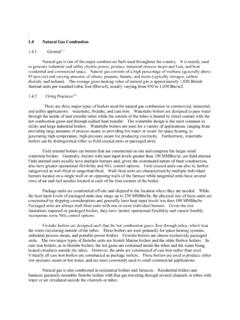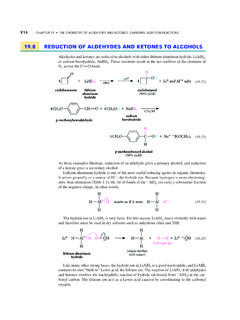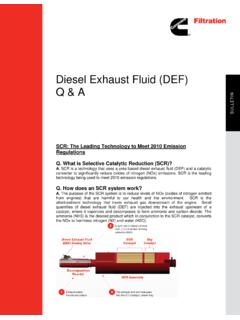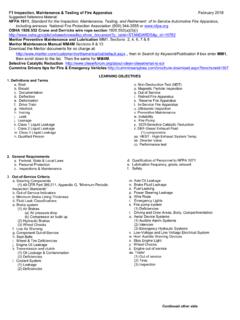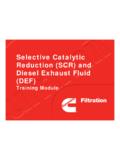Transcription of 32 Urea Fact Sheet - Incitec Pivot Fertilisers
1 UREA FACT Sheet April 2017 Most widely used, and most concentrated solid nitrogen (N) fertiliser 46% N; Economical price per kg of nitrogen; Suitable for dry application to the soil, and in solutions to the soil and in foliar sprays; Also used as a non-protein nitrogen supplement for ruminants (cattle and sheep). MANUFACTURE Urea [CO(NH2)2] is a soluble organic compound containing 46% nitrogen. It occurs naturally in urine and some moulds and fungi. Urea is manufactured synthetically by reacting natural gas, atmospheric nitrogen and water together at high temperature and pressure to produce ammonia and carbon dioxide. These gases are then reacted at high temperature and pressure to produce molten (liquid) urea. This is then cooled and manufactured into granules or prills for industrial use and as an agricultural fertiliser. The hot melt can also be used to prepare urea solutions.
2 Incitec Pivot manufactures granular urea in Brisbane, the only plant of its type in Australia. The nation is not self-sufficient in urea and a considerable quantity is imported to supplement local production. Urea (46% N) is the most concentrated solid nitrogen fertiliser and the most commonly used. Urea has gained in popularity and market share over the last 50 years, and now accounts for around half of the world s use of manufactured nitrogen fertiliser. Urea may be applied as a solid or in solution (dissolved in water) to the soil or as a foliar spray. It is also used in dry blends with products such as the ammonium phosphates (MAP and DAP) and Muriate of Potash. It should not be blended with superphosphate. Urea reacts with and absorbs water from the superphosphate, the mixture becoming sticky and unusable within a short time. As a non-protein nitrogen supplement for ruminants (cattle and sheep) urea allows grazing animals to make better use of low protein roughage (dry grass) during the dry season and with the onset of drought.
3 One of the main industrial uses of urea is in the manufacture of urea formaldehyde resins and glues for the production of particle board and other timber products for the building industry. Urea is also used in the preparation of urea solutions including Urea Ammonium Nitrate (UAN) and selective catalytic reduction (SCR) Urea. UAN is used as a liquid nitrogen fertiliser. It is marketed by Incitec Pivot Fertilisers as EASY N. SCR Urea is used as an exhaust-scrubbing agent in heavy-duty diesel motors, to improve performance and reduce nitrous oxides (NOx) emissions. NOx contributes to the formation of smog. Incitec Pivot manufactures SCR Urea in Brisbane. It is sold as AdBlue , the Registered Trademark of The Verband Der Automobilindustrie (VDA). UREA IN THE SOIL Although urea can be taken up directly by some plants, the nitrogen in urea is more readily available to plants after mineralisation in the soil to ammonium (NH4+) and nitrate (NO3-).
4 After application, urea is converted to ammonium by the action of urease, a naturally occurring enzyme present in the soil. This process is known as ammonification and is usually completed within a few days. Soil bacteria then convert the ammonium to nitrate. This process is called nitrification and is usually completed within a few weeks. Ammonium nitrogen is strongly adsorbed onto soil particles. Nitrate is not and can be leached by heavy rainfall or excessive irrigation. Losses by leaching are most likely to occur on light textured, sandy soils. Nitrate nitrogen may also be lost to the atmosphere through denitrification if the soil becomes water-logged. Soil micro-organisms, deprived of their usual source of oxygen (O2), will reduce nitrate (NO3-) to gaseous forms, nitrous oxides and molecular nitrogen (N2). Gaseous loss to the atmosphere may also occur as a result of the volatilisation of ammonia gas if urea is applied to the soil surface without incorporation.
5 These losses can be suppressed by soil coverings of 3 cm or by irrigating immediately after application. In the soil, ammonium (NH4+) ions are attracted and tightly held (adsorbed) on the surface of clay and humus particles. Some ammonium remains in solution, but as most is adsorbed, it is not easily leached from the root zone. Nitrogen losses through leaching and to the atmosphere are not confined to urea. Nitrogen from other nitrogen Fertilisers , and that present naturally in the soil (mineralised from soil organic matter), is also subject to loss. In choosing appropriate fertiliser management practices, the likely mechanisms of loss should be determined, and steps taken to minimise them. USE AS A FERTILISER In common with other nitrogen Fertilisers , there are limits to how much nitrogen can be safely applied as urea in direct contact with the seed at planting in annual crops and in foliar sprays without burning plant tissue.
6 In grain and cotton crops, urea is often drilled into the soil during the fallow period prior to planting. This is the norm on heavy textured clay soils in the inland cropping areas of northern NSW and Qld. In high rainfall areas and on sandy soils (where nitrogen can be lost through leaching) and where good in-season rainfall is received during the growing season, urea is often top-dressed after planting. This is a common practice in winter grain crops in southern Australia where the rainfall is winter dominant and more reliable than in northern Australia, where the growth of crops is very reliant on conserved moisture accumulated during the fallow period. The probability of follow-up rain to wash fertiliser into the soil and the crop s root zone in the spring is higher in the southern States than in northern NSW and Queensland. Vegetable and other row crops are side-dressed with urea during the growing season. In sugarcane, urea is side-dressed after planting, and re-applied to each ratoon crop.
7 Pastures and forage crops are top-dressed as required during the growing season. Fertigation (dissolving fertiliser in irrigation water) allows regular applications of urea to be made using the little and often approach in irrigated crops. This does allow nutrient supply to be more closely matched to plant demand and crop uptake. With few exceptions, foliar sprays can not be used to meet a crop s entire requirements for macronutrients such as nitrogen without burning the plant foliage. Foliar sprays of urea are used to supplement rather than replace soil applications. They are used during peak demand periods and where a quick response is required, to help correct a deficiency in horticultural crops.


